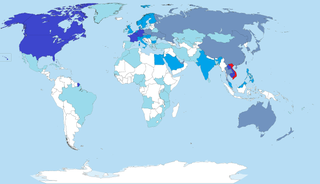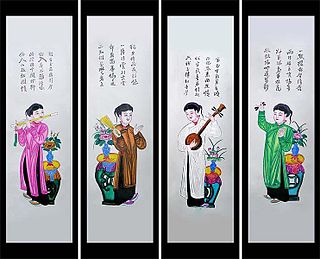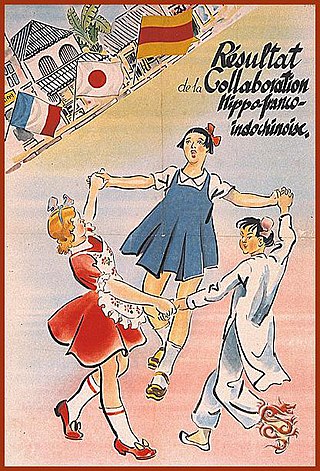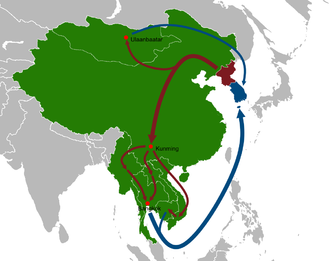
Transportation in Vietnam is improving rapidly in terms of both quantity and quality. Road traffic is growing rapidly but the major roads are dangerous and slow to travel on due to outdated design and an inappropriate traffic mix. In recent years, the construction of expressways has accelerated. Air travel is also important for long-distance travel. The two major metropolises of Hanoi and Ho Chi Minh City have operating metro networks which are currently being expanded.

Ho Chi Minh City, better known and colloquially referred to as Saigon, is the most populous city in Vietnam, with a population of around 10 million in 2023. The city's geography is defined by rivers and canals, of which the largest is Saigon River. As a municipality, Ho Chi Minh City consists of 16 urban districts, five rural districts, and one municipal city (sub-city). As the largest financial centre in Vietnam, Ho Chi Minh City has the largest gross regional domestic product out of all Vietnam provinces and municipalities, contributing around a quarter of the country's total GDP. Ho Chi Minh City's metropolitan area is ASEAN's 6th largest economy, also the biggest outside an ASEAN country capital.

Hồ Chí Minh, colloquially known as Uncle Ho and by other aliases and sobriquets, was a Vietnamese revolutionary and politician who served as the founder and first president of the Democratic Republic of Vietnam from 1945 until his death in 1969, and as its first prime minister from 1945 to 1955. Ideologically a Marxist–Leninist, he founded the Indochinese Communist Party in 1930 and its successor Workers' Party of Vietnam in 1951, serving as the party's chairman until his death.

Overseas Vietnamese are Vietnamese people who live outside Vietnam. There are approximately 5 million overseas Vietnamese, the largest community of whom live in the United States.

The cinema of Vietnam originates in the 1920s and was largely influenced by wars that have been fought in the country from the 1940s to the 1970s.
Association football in Vietnam is run by the Vietnam Football Federation. The federation administers the Vietnamese Men's and Women's national football teams. It is responsible for the national football leagues, including the V. League 1, which is a top tier league.
Vietnamese people in Korea, also known as Vietnamese Koreans, have a history dating back to the 12th century. After the division of Korea and the Korean War, ethnic Vietnamese had various contacts with both North and South Korea. They are Vietnamese expatriates in Korean peninsular or Korean born-citizens were born of partially or full Vietnamese descent. In the latter, Vietnamese are the second-largest group of foreigners, after Chinese migrants.

India–Vietnam relations, also known as Indian-Vietnamese relations, are the bilateral relations of India and Vietnam.
The North–South express railway is a planned high speed railway in Vietnam. The line would begin in Thanh Trì and end in Thủ Đức, connecting the two most urbanised areas in the country: Hanoi in the North, and Ho Chi Minh City in the South. This project is part of the country's railway transport development strategy by 2020 with a vision to 2050. The project is also part of the Trans-Asian railway network. Vietnam’s National Assembly approved the $67 billion railway in November 2024.

North Vietnam, officially the Democratic Republic of Vietnam, was a country in Southeast Asia from 1945 to 1976, with sovereignty fully recognized in 1954. A member of the communist Eastern Bloc, it opposed the French-supported State of Vietnam and later the Western-allied Republic of Vietnam. The DRV emerged victorious over South Vietnam in 1975 and ceased to exist the following year when it unified with the south to become the current Socialist Republic of Vietnam.

The railway system in Vietnam is owned and operated by the state-owned Vietnam Railways. The principal route, the single track North-South Railway running between Hanoi and Ho Chi Minh City, accounts for 1,726 kilometres (1,072 mi) of the network's total length of 2,600 kilometres (1,600 mi). The national railway network uses mainly metre gauge, although there are several standard gauge and mixed gauge lines in the north of the country.

The North–South railway is the principal railway line serving the country of Vietnam. It is a single-track metre gauge line connecting the capital Hanoi in the north to Ho Chi Minh City in the south, for a total length of 1,726 km (1,072 mi). Trains travelling this line are sometimes referred to as the Reunification Express, although no particular train carries this name officially. The line was established during French colonial rule, and was completed over a period of nearly forty years, from 1899 to 1936. As of 2005, 191 of Vietnam's 278 railway stations were located along the North–South line.

This article presents an overview of the Sports in Vietnam.

The community of Japanese expatriates and descendants in Vietnam consist mainly of Japanese expatriates and migrants residing in Vietnam, as well as their descendants who identify their ancestry to be Japanese. As of 2016, there are about 16,145 Japanese residents in Vietnam, mostly around Hanoi.

Taiwan–Vietnam relations are conducted on an unofficial level, as Hanoi adheres to a one-China policy and officially recognises the People's Republic of China only and considers Taiwan to be an "inseparable part" of China's territory. However, this has not stopped bilateral visits, immigration and investment capital between Taiwan and Vietnam. Taiwan has been the fourth largest source of foreign direct investment in Vietnam since 2006. Both countries maintain representative offices; Taiwan is represented by the Taipei Economic and Cultural Office in Hanoi and Ho Chi Minh City (Saigón), while Vietnam is represented by the Vietnam Economic and Cultural Office in Taipei, both acting as de facto embassies. Vietnam is, to date, the only communist state to have informal relations with Taiwan.

Phan Kế An, also known under the pseudonym Phan Kích, was a Vietnamese painter and renowned lacquer artist. He was the son of Phan Kế Toại (1892–1973) who was the personal envoy to Tonkin of the last Emperor of Vietnam, Bảo Đại, the Minister of Home Affairs (1945-1955) and former deputy prime minister of North Vietnam from 1955-1973.

In mid-1940, Nazi Germany rapidly defeated the French Third Republic, and the colonial administration of French Indochina passed to the French State. Many concessions were granted to the Empire of Japan, such as the use of ports, airfields, and railroads. Japanese troops first entered parts of Indochina in September 1940, and by July 1941 Japan had extended its control over the whole of French Indochina. The United States, concerned by Japanese expansion, started putting embargoes on exports of steel and oil to Japan from July 1940. The desire to escape these embargoes and to become self-sufficient in resources ultimately contributed to Japan's decision to attack on December 7, 1941, the British Empire and simultaneously the United States. This led to the United States declaring war against Japan on December 8, 1941. The United States then joined the side of the British Empire, at war with Germany since 1939, and its existing allies in the fight against the Axis powers.

North Korea and the former country North Vietnam established formal diplomatic relations on January 31, 1950. In July 1957, North Vietnam President Ho Chi Minh visited North Korea; North Korean prime minister Kim Il Sung visited North Vietnam in November–December 1958 and November 1964. In February 1961, the two governments concluded an agreement on scientific and technical cooperation. North Vietnam merged with South Vietnam in 1976 to become the modern country of Vietnam.
















